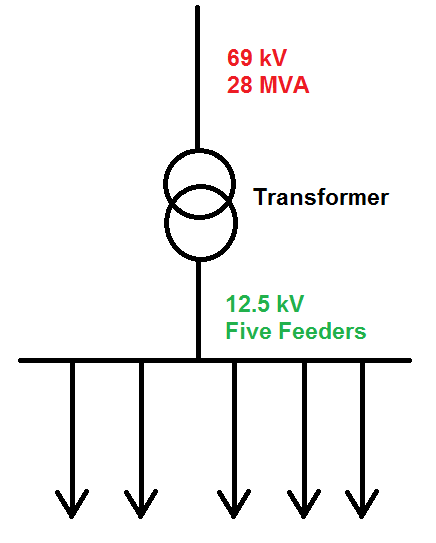Distribution Substation
Note: This problem is meant to be very easy, but there is a lot of text just to provide background
A three-phase distribution substation steps voltage down from to . These voltages are AC, RMS, line-to-line. The unit denotes one thousand volts.
The step-down transformer passes a total three-phase apparent power of , where "VA" stands for "volt-amperes". A single-line diagram is shown for convenience.

Five identical distribution feeders are fed from a common bus on the low-voltage side of the transformer. Assuming the transformer to be lossless for simplicity, each distribution feeder takes one fifth of the total apparent power flowing through the transformer.
The following expression relates the total three-phase apparent power on each feeder to the feeder line-to-line voltage and per-phase feeder current .
Note that the units of in the equation are volt-amperes, the units for are volts RMS, and the units for are amps RMS. All quantities in the equation are scalars (real numbers). A current of magnitude flows in each of the three phases.
For each feeder, what is the value of ?
The answer is 258.65.
This section requires Javascript.
You are seeing this because something didn't load right. We suggest you, (a) try
refreshing the page, (b) enabling javascript if it is disabled on your browser and,
finally, (c)
loading the
non-javascript version of this page
. We're sorry about the hassle.
Assuming no loss at the transformer, each of the feeders get a fifth of the total apparent power. That is S = 3 V L L I L = 5 2 8 × 1 0 6 ⟹ I L = 5 3 × 1 2 . 5 × 1 0 3 2 8 × 1 0 6 ≈ 2 5 8 . 6 5 3 A .